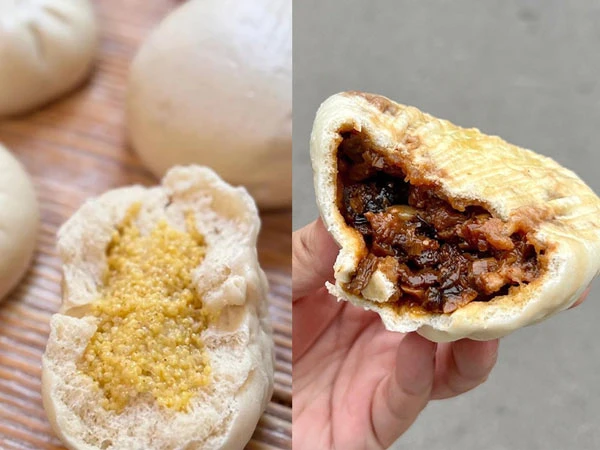A Bite of Shandong: The World of Baozi
In Shandong, the love for Baozi isn't just a culinary preference—it's a cultural phenomenon. Recently, the internet has been abuzz with playful jabs and fond reflections on Shandong people's obsession with these steamed buns. To the locals, the universe might be imagined as a giant Baozi, perfectly round, pleated, and filled with endless possibilities.
For outsiders, their first encounter with Shandong Baozi can be quite the surprise. These buns are often significantly larger than those found elsewhere in China, embodying the robust and hearty spirit of the Shandong people. Each Baozi reflects the agricultural abundance, geographical characteristics, and cultural depth of the region.

The Agricultural Backbone: Why Shandong Baozi Are So Big
Shandong is one of China's agricultural powerhouses, especially when it comes to wheat production. The North China Plain, where Shandong is located, is a prime wheat-growing region, supplying the province with ample high-quality flour. This abundant resource has made wheat-based foods, like Baozi, a staple in Shandong's daily diet.
But the size of Shandong Baozi isn't just about having plenty of flour. It also ties into the region's climate. Shandong's winters are long and harsh, requiring people to consume more calories to stay warm and sustain energy for physical labor. In the past, when vegetable variety was limited, especially in the colder months, hearty wheat-based foods became the go-to option. Baozi, with their generous fillings and substantial size, were the perfect solution—providing a full meal in just one or two buns.
Moreover, Shandong's Baozi represent more than just sustenance; they reflect a historical longing for abundance. In the past, white flour was a luxury, often reserved for special occasions. Baozi, made from this prized ingredient, symbolized prosperity and good fortune. This cultural significance has endured, making Baozi a cherished part of Shandong's culinary landscape.
The Heart of Hospitality: Baozi as a Symbol of Shandong Culture
Shandong is known for its hospitality, and Baozi play a central role in this tradition. When guests arrive, serving a plate of steaming hot Baozi is a gesture of warmth and generosity, embodying the Shandong ethos of being hearty and welcoming. The large size of these Baozi is a testament to this spirit—ensuring that no guest leaves the table hungry.
The practical, no-nonsense approach of Shandong people extends to their food as well. In Shandong, Baozi are not just an accompaniment to a meal; they are the meal. A single Baozi, filled with a mixture of vegetables and meat, is enough to satisfy the hunger of an adult. This simplicity and practicality are deeply ingrained in the Shandong way of life.
Seasonal Flavors: The Ever-Changing Fillings of Shandong Baozi
One of the most charming aspects of Shandong Baozi is the way their fillings change with the seasons, reflecting the region's agricultural cycles. In spring, fresh radish greens and wild herbs like mountain dock make their way into the buns, bringing a unique freshness to each bite. As summer approaches, long beans, known locally as "doujuezi (豆角子)," become the star ingredient, offering a rich, full-bodied flavor.
During the transition from summer to autumn, chives take center stage, often paired with fatty pork and seaweed for a filling that's both aromatic and satisfying. As winter sets in, the humble cabbage and radish return to the forefront, anchoring the diet in the colder months. Each season brings its own set of flavors, ensuring that Shandong Baozi are never monotonous.
But it's not just the seasonality that makes Shandong Baozi special. The sheer variety of fillings is staggering. From the robust flavors of braised pork belly mixed with onions and sweet bean paste to the delicate sweetness of yellow millet-filled buns, there's a Baozi for every palate. Some of the more adventurous fillings include seafood Baozi, stuffed with fresh catches like sea cucumber, abalone, and shrimp, showcasing Shandong's coastal bounty.
For those with a sweet tooth, Shandong also offers Baozi as a dessert. One popular variety is the sticky yellow millet Baozi, a soft, chewy delight that has become a favorite among children and adults alike. Another treat is the silver thread rolls, where sweet dough is pulled into fine strands before being steamed to perfection, creating a light and subtly sweet bite.
More Than Just Food, A Way of Life
In Shandong, Baozi are more than just food; they are a way of life, a symbol of family, and a marker of tradition. Many Shandong natives have fond memories of family gatherings centered around making Baozi. Each family member had a role—kneading the dough, rolling the wrappers, preparing the fillings, and folding the buns into their final shape. This communal activity not only produced food but also strengthened familial bonds and passed down culinary skills through generations.
Even as adults, Shandong people often find that Baozi bring a sense of comfort and connection to their roots. The act of steaming Baozi, with their familiar aroma filling the kitchen, can evoke a deep sense of nostalgia and belonging. It's a taste of home, no matter how far away one might be.
For Shandong people living far from home, frozen Baozi often become a lifeline to their heritage. Families might send these buns across the country—or even across the world—preserving the tradition and providing a tangible link to their homeland.
In Shandong, the story of Baozi is more than just a tale of food; it's a story of culture, history, and identity. Each bite of a Shandong Baozi is a taste of the region's rich agricultural heritage, its cultural values, and the enduring love of its people for this humble yet profoundly significant food.



